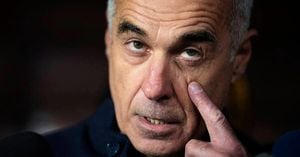Intel, the chip-making giant, has recently signed off on receiving $7.86 billion from the U.S. government as part of its CHIPS and Science Act initiative aimed at boosting domestic semiconductor production. This funding marks the largest ever award under the CHIPS Act, aimed at reducing reliance on foreign chip manufacturers and revitalizing the U.S. semiconductor industry amid national security concerns and global supply chain struggles.
Originally anticipated to receive up to $8.5 billion, Intel’s grant was trimmed following its failure to meet some preliminary objectives and its internal economic challenges. A notable aspect of this funding package is the $3 billion designated for developing chips for the defense sector, reinforcing the government's strategy to bolster both commercial and military chip capabilities.
President Biden’s administration, with significant backing from the Commerce Department, is using this strategy not only to address job creation but also to reestablish America's status as a leader in semiconductor technology. White House Deputy Chief of Staff Natalie Quillian emphasized how this funding aligns with revitalizing manufacturing and generating thousands of jobs. The project is expected to generate as many as 30,000 jobs across several states, including Arizona, New Mexico, Ohio, and Oregon, with substantial physical expansions planned for Intel's fabrication facilities.
Despite this financial assistance, Intel has been grappling with its share of problems over the past few months. The company faced staggering financial losses, reporting its largest quarterly loss since its inception—$16.6 billion. It has also laid off approximately 15,000 employees as part of its restructuring measures aimed at mitigating financial strains. Compounding these issues are the manufacturing challenges with its next-generation 18A process, which have led to significant operational delays.
Intel’s ambitious plans have also seen notable cutbacks; its expected job creation figures, especially for its expansion project in Ohio, have been reduced from 10,000 to about 6,500 jobs. On top of this, the anticipated investment from the company has dipped from $100 billion now expected to reach around $90 billion by the decade's end. These adjustments reflect the company's drive to stabilize its finances amid fierce competition primarily from overseas producers.
Central to the funding agreement is Intel's commitment to not only maintaining operations within the U.S. but also to continuing its research and development investments. Intel is obliged to invest at least $35 billion from 2024 to 2028 on R&D domestically and to build and operate several advanced facilities across the aforementioned states. These agreements also impose restrictions on how Intel can maneuver its Foundry unit, should it choose to spin it off as either a private or public entity.
Under the terms of the agreement, Intel would be required to retain at least 50.1% ownership of the Foundry business if it transitions to private status, and if made public, it cannot allow any single entity to possess more than 35% ownership without Intel being the predominant shareholder. Such restrictions are set to manage outside influence over this key segment of the business and to align with national objectives concerning technological sovereignty.
Interestingly, the recent CHIPS Act provisions mirror broader government endeavors aimed at shaping control over advanced technologies. This could be seen as part of the government’s strategy to not only stimulate economic competitiveness but also protect national interests against potential foreign takeover.
With all these factors at play, Intel's immediate future rests not only on how effectively it can navigate these challenges but also on how the broader market reacts to its strategic pivots. Intel's leaders have acknowledged these hurdles, with CEO Pat Gelsinger stating the need for the company to start rebuilding its reputation and operational efficiency. The firm’s executives are engaged actively with investors and stakeholders, focusing on signaling strong prospects for growth and recovery.
Intel’s recent dealings also hint at the tumultuous climate surrounding the semiconductor industry as it navigates the interplay between the government, market expectations, and its operational realities. The hope is to project strength and stability during transitioning periods, highlighting the need for strategic investments and partnerships within the industry.
Moving forward, how Intel manages this grant and the associated expectations could dictate its role as both a tech leader and pivotal player within American manufacturing. The future is undeniably intertwined with how well Intel can execute its plans amid these overarching pressures in the chip-making sector.



